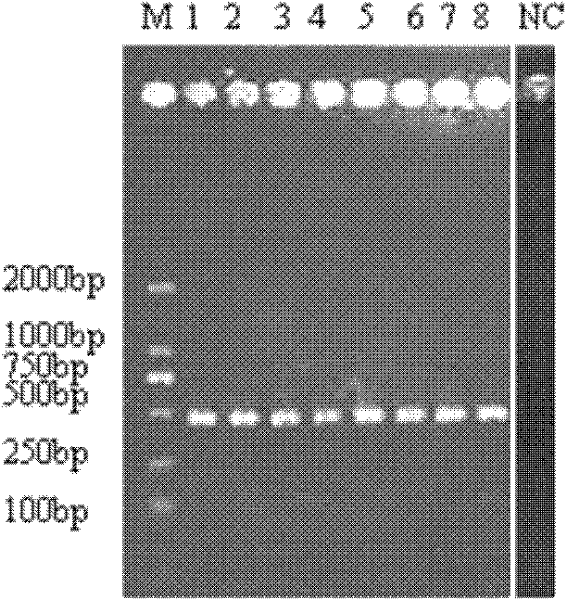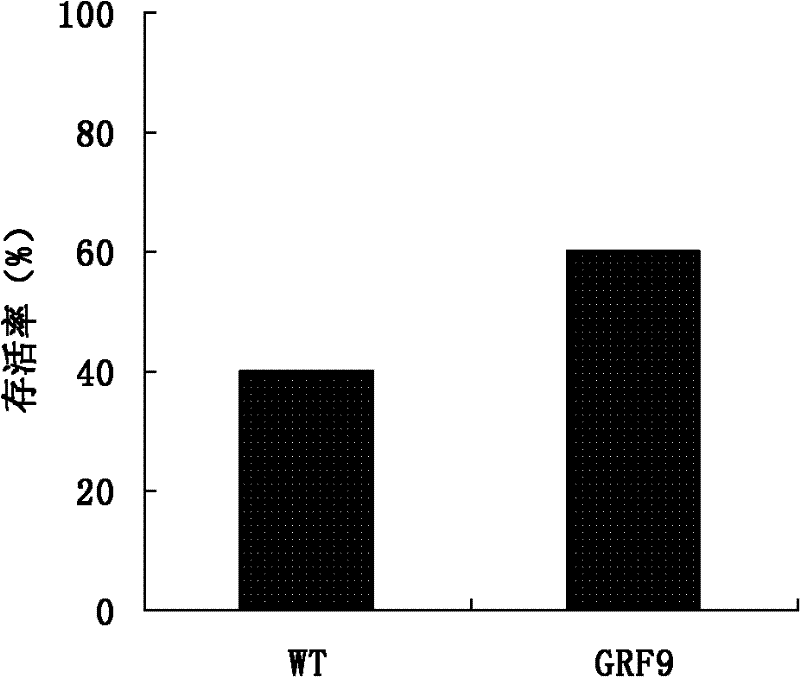Stress tolerance related 14-3-3 protein GRF9 and application thereof
A technology of stress tolerance and plant stress tolerance, applied in the field of plant genetic engineering, can solve problems such as soil secondary salinization, crop yield decline, degradation, etc., and achieve the effect of drought resistance and low temperature resistance
- Summary
- Abstract
- Description
- Claims
- Application Information
AI Technical Summary
Problems solved by technology
Method used
Image
Examples
Embodiment 1
[0018] Example 1: Cloning of Arabidopsis 14-3-3 protein grf9 gene and construction of plant expression vector
[0019] The specific primers were designed according to the DNA information (NM_001036456) of the grf9 gene of Arabidopsis thaliana published by NCBI. The 5'end of the upstream primer was added with the XbaI restriction site, and the 5'end of the downstream primer was added with the SacI restriction site. The PCR product is 1332bp. Upstream primer F1: 5′-GC TCTAGA GTAGTAATTACCCCGTTTAACCCG-3' (adding XbaI restriction site), downstream primer R1: 5'-GCGAGCTCCTCAGCAATTCAGAAATGAAGGAAT-3' (adding SacI restriction site). Extract the total RNA of Arabidopsis thaliana grown in hydroponic culture for 15 days and use it as a template. Oligo(dT) 18 For primer reverse transcription, the reverse transcription product cDNA is obtained. Using this cDNA as a template, PCR amplification was performed with specific primers F1 and R1. Then the pMD18 simple vector was used for TA cloning...
Embodiment 2
[0021] Example 2: Preparation of transgenic tomatoes
[0022] The steps to transform tomato with LBA4404::GRF9-pBI121 are as follows:
[0023] (1) Cultivation of Agrobacterium: Pick a single colony of LBA4404::GRF9-pBI121 from the plate and inoculate it with 100mgL -1 kanamycin(Kan), 25mg L -1 rifampicin (Rif) and 50mg L -1 Streptomycin (Strep) in Luria-Bertani (LB) liquid medium, 28℃, 250rpm shaking culture to OD 600nm =1.0, dilute the bacterial solution 10 times with LB liquid medium, continue shaking and culture for 4h; pour the bacterial solution into a sterile screw-top centrifuge tube with a lid, cover the tube, and centrifuge at 4000 rpm for 10 minutes; discard the supernatant and invert the centrifuge tube 1min, drain off the remaining liquid; add an appropriate amount of co-culture medium-I (MS, 30g L -1 Sucrose, pH 5.8), suspend the bacteria, transfer to a sterile container, use co-culture liquid medium-I, and dilute to OD again 600nm = 0.1.
[0024] (2) Pre-cultivati...
Embodiment 3
[0028] Example 3: Detection of tolerance to low phosphorus and / or drought and / or low temperature tolerance of transgenic grf9 tomato
[0029] (1) Determination of phosphorus content in genetically modified tomatoes: T 2 Generation transgenic tomatoes were planted in the greenhouse of Nanjing Institute of Soil Science, Chinese Academy of Sciences. The soil used for greenhouse potting was collected from the vegetable growing area (greenhouse soil) in Yixing City, Jiangsu Province. T 2 One month after the generation of transgenic tomatoes were transplanted into the soil, harvest the above-ground samples and control samples of the transgenic tomatoes, wash them with deionized water, divide them into different parts, kill them at 105°C for 30 minutes, and dry them to constant weight at 65°C; crush; ; Weigh. The results showed that under the same phosphorus supply conditions, the biomass of genetically modified tomatoes increased significantly (Table 1). It shows that the transgenic ...
PUM
 Login to View More
Login to View More Abstract
Description
Claims
Application Information
 Login to View More
Login to View More - R&D
- Intellectual Property
- Life Sciences
- Materials
- Tech Scout
- Unparalleled Data Quality
- Higher Quality Content
- 60% Fewer Hallucinations
Browse by: Latest US Patents, China's latest patents, Technical Efficacy Thesaurus, Application Domain, Technology Topic, Popular Technical Reports.
© 2025 PatSnap. All rights reserved.Legal|Privacy policy|Modern Slavery Act Transparency Statement|Sitemap|About US| Contact US: help@patsnap.com



